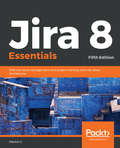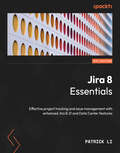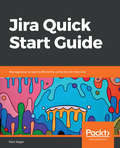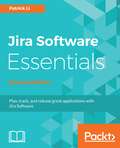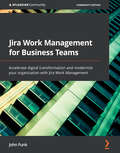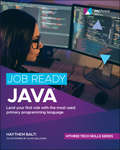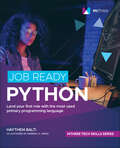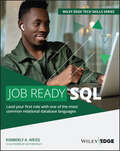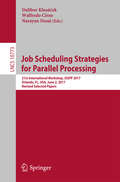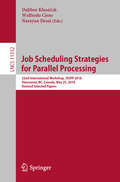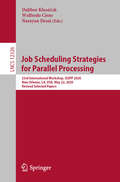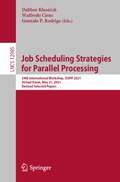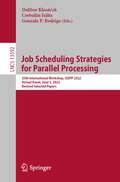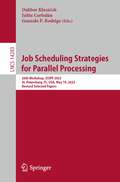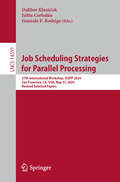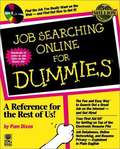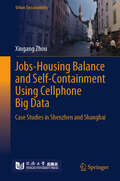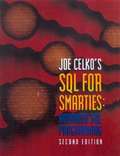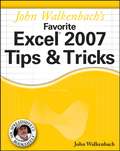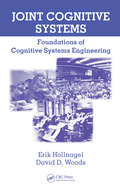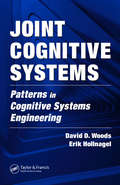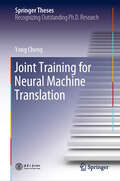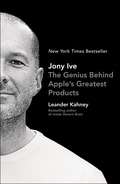- Table View
- List View
Jira 8 Essentials - Fifth Edition: Effective Issue Management And Project Tracking With The Latest Jira Features, 5th Edition
by Patrick LiThis book will be especially useful for project managers but it's also intended for other Jira users, including developers, and any other industry besides software development, who would like to leverage Jira's powerful task management and workflow features to better manage their business processes.
Jira 8 Essentials: Effective project tracking and issue management with enhanced Jira 8.21 and Data Center features, 6th Edition
by Patrick LiImplement future-proof solutions for all types of teams with Data Center by learning about performance, reliability, scalability, and securityPurchase of the print or Kindle book includes a free PDFKey FeaturesExplore all of Jira's core features as well as the advanced features offered by Data CenterLearn to use Jira for issue management, field management, screen management, and business workflowsInstall, update, and manage third-party apps from Atlassian marketplace to extend Jira capabilitiesBook DescriptionThis new and improved sixth edition comes with the latest Jira 8.21 Data Center offerings, with enhanced features such as clustering, advanced roadmaps, custom field optimization, and tools to track and manage tasks for your projects. This comprehensive guide to Jira 8.20.x LTS version provides updated content on project tracking, issue and field management, workflows, Jira Service Management, and security.The book begins by showing you how to plan and set up a new Jira instance from scratch before getting you acquainted with key features such as emails, workflows, and business processes. You'll also get to grips with Jira's data hierarchy and design and work with projects. Since Jira is used for issue management, this book will help you understand the different issues that can arise in your projects. As you advance, you'll create new screens from scratch and customize them to suit your requirements. Workflows, business processes, and guides on setting up incoming and outgoing mail servers will be covered alongside Jira's security model and Jira Service Management. Toward the end, you'll learn how Jira capabilities are extended with third-party apps from Atlassian marketplace.By the end of this Jira book, you'll have understood core components and functionalities of Jira and be able to implement them in business projects with ease.What you will learnExamine various deployment options and system requirements for hosting Jira Data CenterUnderstand Jira's data hierarchy and learn how to design and work with projects in JiraUse Jira for agile software projects, business process management, customer service support, and moreExplore field configuration schemes and find out how to apply them to projectsDevelop and design customized screens and apply them to different projectsCreate configurable reports on projects and share information through dashboards for reporting and analysisWho this book is forThis book is especially useful for project managers, but it's also intended for other Jira users, including developers, and any other industry besides software development, who would like to leverage Jira's powerful task management and workflow features to better manage their business processes.
Jira Quick Start Guide: Manage your projects efficiently using the all-new Jira
by Ravi SagarLeverage Jira's powerful task management and workflow features to better manage your business processes Key Features The book covers all major applications of Jira, which are Jira Software, Jira Core, Jira Service Desk. Configure project workflows and the fields that will be used in the project with the help of Jira's features Create tickets for issues and manage your projects using the Jira software Book Description Jira is an issue tracker and project management system. With their latest release, the Jira team has now expanded their user base to agile teams as well as business teams. This book provides a comprehensive explanation covering all major components of Jira, including Jira Software, Jira Core, and Jira Service Desk. This book starts with an introduction to Jira's unique features and how it can be used as an issue-tracking tool. It will then teach you about how a new project is created by a Jira administrator, what responsibilities there are, and using correct and relevant schemes in your project. You will then learn how to configure project workflows and fields for project screens. You will understand the various permissions used in projects and the importance of project roles in Jira. Then, the book talks about the concepts of versions acting as milestones and using components when handling issues in your projects. It will then focus on analysing data using built-in reports and creating dashboards in Jira. At the end, it will discuss various best practices for users as well as project managers or project administrators. What you will learn Implement Jira as a project administrator or project manager Get familiar with various functionalities of Jira Configure projects and boards in your organisation's Jira instance Understand how and when to use components and versions in your projects Manage project configurations and Jira schemes Learn the best practices to manage your Jira instance Who this book is for This book will be especially useful for project managers but it's also intended for other Jira users, including developers, and any other industry besides software development, who would like to use Jira for project management.
Jira Software Essentials - Second Edition: Plan, track, and release great applications with Jira Software
by Patrick LiExplore Jira Software to manage your projects proficiently Key Features Plan and manage projects effortlessly with Jira Software by integrating it with other applications Improve your team's performance with Scrum and Kanban, together with agile methodology Easy-to-follow learning guide to install Jira Software and understand how it fits in with Atlassian Jira Book Description Jira Software is an agile project management tool that supports any agile methodology, be it scrum, Kanban, or your own unique flavour. From agile boards to reports, you can plan, track, and manage all your agile software development projects from a single tool. Jira Software brings the power of agile methodology to Atlassian Jira. This second edition of JIRA Agile Essentials, will help you dive straight into the action, exploring critical agile terminologies and concepts in the context of Jira Software. You will learn how to plan, track, and release great software. This book will teach you how to install and run Jira Software and set it up to run with Scrum and Kanban. It will also teach you to use Jira Software your way and run projects beyond the out-of-box Scrum and Kanban way, including a hybrid approach of both the methodologies and other options that come with Jira Software. Later, you will learn how to integrate it with the tools you are already using and enhance Jira with add-ons such as Confluence. You will learn to stay connected with your team from anywhere to ensure great development. Jira Software has numerous deployment options in the cloud, on your own infrastructure, or at a massive scale. You will be introduced to Bitbucket, Atlassian’s distributed version control system, which integrates seamlessly with Jira, allowing your team to work within the two applications as one harmonious environment. With this practical guide, you will develop a great working knowledge of Jira Software and your project management will become much more efficient. What you will learn Understand the basics and agile methodologies of Jira software Use Jira Software in a Scrum environment Manage and run Jira Software projects beyond the out of box Scrum and Kanban way Combine Scrum and Kanban and use other project management options beyond just agile Customize Jira Software’s various features and options as per your requirements Work with Jira Agile offline, and plan and forecast projects with agile portfolio Integrate Jira Agile with Confluence and Bitbucket Who this book is for If you want to get started with Jira Software and learn how to run your Jira projects the agile way, then this is the perfect book for you. You will need to be familiar with the basics of Jira, both from an end user's and an administrator's perspective. Experience with workflows, custom fields, and other administrative functions of Jira will be useful.
Jira Work Management for Business Teams: Accelerate digital transformation and modernize your organization with Jira Work Management
by John FunkExplore all the fundamental concepts and major applications of Jira Work Management to build and manage your business projects efficientlyKey FeaturesGet to grips with Jira Core updatesDiscover how to use all the new JWM features such as lists, templates, calendars, and formsLearn about administration schemes, automation, and simple administration capabilitiesBook DescriptionJira Work Management (JWM) is the newest project management tool from Atlassian, replacing Atlassian's previous product, Jira Core Cloud. While Jira Software focuses on development groups, JWM is specifically targeted toward business teams in your organization, such as human resources, accounting, legal, and marketing, enabling these functional groups to manage and enhance their work, as well as stay connected with their company's developers and other technical groups. This book helps you to explore Jira project templates and work creation and guides you in modifying a board, workflow, and associated schemes. Jira Work Management for Business Teams takes a hands-on approach to JWM implementation and associated processes that will help you get up and running with Jira and make you productive in no time. As you explore the toolset, you'll find out how to create reports, forms, and dashboards. The book also shows you how to manage screens, field layouts, and administer your JWM projects effectively. Finally, you'll get to grips with the basics of creating automation rules and the most popular use cases. By the end of this Jira book, you'll be able to build and manage your own Jira Work Management projects and make basic project-related adjustments to achieve optimal productivity.What you will learnUnderstand how JWM can help your company to increase productivityDiscover how to use templates to create projects quickly and with easeLeverage JWM's newest features, including an in-line editable list, a built-in calendar, a roadmap-style timeline, and an updated boardExplore custom fields and see the impact of your project screen arrangementGet to grips with simple administration and how schemes can be used to ease maintenanceFind out how Atlassian Marketplace apps can extend your Jira productDiscover how to use automation to complete routine and repetitive tasksWho this book is forThis book is for product managers and project managers who want to learn how to quickly get started with non-software projects in Jira. End users working as part of functional teams, including human resources, finance, legal, and marketing teams will also benefit greatly from this book. Familiarity with Jira is helpful but not required.
Job Ready Go
by Haythem BaltiTackle GoLang with practical and employment-focused instruction In Job Ready Go, software education guru Dr. Haythem Balti delivers an essential and hands-on guide to Go, an open-source programming language developed by Google engineers to combine the most sought-after capabilities of other programming languages, including Java, C#, and C++. In the book, the author walks you through all the most critical skills necessary for successful, on-the-job Go programming. You&’ll discover: How to get started with Go, including how to run, build, and test your own go programs Understand control flow and data structures in Go including arrays, slices, maps, and pointerss How to leverage structs, interfaces, and methods to organize and reuse code How to leverage go to process data, access different types of files and develop APIs Leverage concurrency and gRPCs to create complex and interconnected systems. Job Ready Go offers readers straightforward and elegant instruction based on the renowned mthree Global Academy and Software Guild training program. It&’s an essential read for aspiring Go developers looking for a fast-track to developing real-world skills demanded by employers.
Job Ready Java
by Haythem Balti Alan GallowayPrepare yourself to take on new and exciting Java programming challenges with this one-stop resource Job Ready Java delivers a comprehensive and foundational approach to Java that is immediately applicable to real-world environments. Based on the highly regarded and effective Software Guild Java Bootcamp: Object Oriented Programming course, this book teaches you the basic and advanced Java concepts you will need at any entry-level Java position. With the “Pulling It Together” sections, you’ll combine and integrate the concepts and lessons taught by the book, while also benefiting from: A thorough introduction to getting set up with Java, including how to write, compile, and run Java programs with or without a Java IDE Practical discussions of the basics of the Java language, including syntax, program flow, and code organization A walk through the fundamentals of Object-Oriented Programming including Classes, Objects, Interfaces, and Inheritance, and how to leverage OOP in Java to create elegant code. Explorations of intermediate and advanced Java concepts, including Maven , unit testing, Lambdas, Streams, and the Spring Framework Perfect for Java novices seeking to make a career transition, Job Ready Java will also earn a place in the libraries of Java developers wanting to brush up on the fundamentals of their craft with an accessible and up-to-date resource.
Job Ready Python
by Haythem Balti Kimberly A. WeissGet ready to take on Python with a practical and job-focused guide Job Ready Python offers readers a straightforward and elegant approach to learning Python that emphasizes hands-on and employable skills you can apply to real-world environments immediately. Based on the renowned mthree Global Academy and Software Guild training program, this book will get you up to speed in the basics of Python, loops and data structures, object-oriented programming, and data processing. You’ll also get: Thorough discussions of Extract, Transform, and Load (ETL) scripting in Python Explorations of databases, including MySQL, and MongoDB—all commonly used database platforms in the field Simple, step-by-step approaches to dealing with dates and times, CSV files, and JSON files Ideal for Python newbies looking to make a transition to an exciting new career, Job Ready Python also belongs on the bookshelves of Python developers hoping to brush up on the fundamentals with an authoritative and practical new handbook.
Job Ready SQL
by Haythem Balti Kimberly A. WeissLearn the most important SQL skills and apply them in your job—quickly and efficiently! SQL (Structured Query Language) is the modern language that almost every relational database system supports for adding data, retrieving data, and modifying data in a database. Although basic visual tools are available to help end-users input common commands, data scientists, business intelligence analysts, Cloud engineers, Machine Learning programmers, and other professionals routinely need to query a database using SQL. Job Ready SQL provides you with the foundational skills necessary to work with data of any kind. Offering a straightforward ‘learn-by-doing’ approach, this concise and highly practical guide teaches you all the basics of SQL so you can apply your knowledge in real-world environments immediately. Throughout the book, each lesson includes clear explanations of key concepts and hands-on exercises that mirror real-world SQL tasks. Teaches the basics of SQL database creation and management using easy-to-understand language Helps readers develop an understanding of fundamental concepts and more advanced applications such as data engineering and data science Discusses the key types of SQL commands, including Data Definition Language (DDL) commands and Data Manipulation Language (DML) commands Includes useful reference information on querying SQL-based databasesJob Ready SQL is a must-have resource for students and working professionals looking to quickly get up to speed with SQL and take their relational database skills to the next level.
Job Scheduling Strategies for Parallel Processing: 18th International Workshop, Jsspp 2014, Phoenix, Az, Usa, May 23, 2014. Revised Selected Papers (Lecture Notes in Computer Science #8828)
by Walfredo Cirne Narayan Desai Dalibor KlusáčekThis book constitutes the thoroughly refereed post-conference proceedings of the 21st International Workshop on Job Scheduling Strategies for Parallel Processing, JSSPP 2017, held in Orlando, FL, USA, in June 2017.The 10 revised full papers presented in this book were carefully reviewed and selected from 20 submissions. The papers cover topics in the fields of design and evaluation of new scheduling approaches; performance evaluation of scheduling approaches; workloads; consideration of additional constraints in scheduling systems; scaling and composition of very large scheduling systems; cloud provider issues; interaction between schedulers on different levels; interaction between applications/workloads; experience reports from production systems or large scale compute campaigns.
Job Scheduling Strategies for Parallel Processing: 22nd International Workshop, JSSPP 2018, Vancouver, BC, Canada, May 25, 2018, Revised Selected Papers (Lecture Notes in Computer Science #11332)
by Walfredo Cirne Narayan Desai Dalibor KlusáčekThis book constitutes the thoroughly refereed post-conference proceedings of the 22nd International Workshop on Job Scheduling Strategies for Parallel Processing, JSSPP 2018, held in Vancouver, Canada, in May 2018.The 7 revised full papers presented were carefully reviewed and selected from12 submissions. The papers cover topics in the fields of design and evaluation of new scheduling approaches. They focus on several interesting problems in resource management and scheduling.
Job Scheduling Strategies for Parallel Processing: 23rd International Workshop, JSSPP 2020, New Orleans, LA, USA, May 22, 2020, Revised Selected Papers (Lecture Notes in Computer Science #12326)
by Walfredo Cirne Narayan Desai Dalibor KlusáčekThis book constitutes the thoroughly refereed post-conference proceedings of the 23rd International Workshop on Job Scheduling Strategies for Parallel Processing, JSSPP 2020, held in New Orleans, LA, USA, in May 2020.*The 6 revised full papers presented were carefully reviewed and selected from 8 submissions. In addition to this, one invited paper and one keynote pare were included in the workshop. The papers cover topics within the fields of resource management and scheduling. They focus on several interesting problems such as resource contention and workload interference, new scheduling policy, scheduling ultrasound simulation workflows, and walltime prediction. * The conference was held virtually due to the COVID-19 pandemic.
Job Scheduling Strategies for Parallel Processing: 24th International Workshop, JSSPP 2021, Virtual Event, May 21, 2021, Revised Selected Papers (Lecture Notes in Computer Science #12985)
by Walfredo Cirne Dalibor Klusáček Gonzalo P. RodrigoThis book constitutes the thoroughly refereed post-conference proceedings of the 24th International Workshop on Job Scheduling Strategies for Parallel Processing, JSSPP 2021, held as a virtual event in May 2021 (due to the Covid-19 pandemic).The 10 revised full papers presented were carefully reviewed and selected from 17 submissions. In addition to this, one keynote paper was included in the workshop. The volume contains two sections: Open Scheduling Problems and Proposals and Technical Papers. The papers cover such topics as parallel computing, distributed systems, workload modeling, performance optimization, and others.
Job Scheduling Strategies for Parallel Processing: 25th International Workshop, JSSPP 2022, Virtual Event, June 3, 2022, Revised Selected Papers (Lecture Notes in Computer Science #13592)
by Dalibor Klusáček Gonzalo P. Rodrigo Corbalán JulitaThis book constitutes the thoroughly refereed post-conference proceedings of the 25th International Workshop on Job Scheduling Strategies for Parallel Processing, JSSPP 2022, held as a virtual event in June 2022 (due to the Covid-19 pandemic).The 12 revised full papers presented were carefully reviewed and selected from 19 submissions. In addition to this,1 keynote paper was included in the workshop. The volume contains two sections: Technical papers and Open Scheduling Problems.
Job Scheduling Strategies for Parallel Processing: 26th Workshop, JSSPP 2023, St. Petersburg, FL, USA, May 19, 2023, Revised Selected Papers (Lecture Notes in Computer Science #14283)
by Dalibor Klusáček Julita Corbalán Gonzalo P. RodrigoThis book constitutes the thoroughly refereed post-conference proceedings of the 26th International Workshop on Job Scheduling Strategies for Parallel Processing, JSSPP 2023, held in St. Petersburg, FL, USA, during May 19, 2023.The 8 full papers and one keynote paper included in this book were carefully reviewed and selected from 14 submissions. The volume contains two sections: keynote and technical papers.
Job Scheduling Strategies for Parallel Processing: 27th International Workshop, JSSPP 2024, San Francisco, CA, USA, May 31, 2024, Revised Selected Papers (Lecture Notes in Computer Science #14591)
by Dalibor Klusáček Julita Corbalán Gonzalo P. RodrigoThis book constitutes the refereed proceedings of the 27th International Workshop on Job Scheduling Strategies for Parallel Processing, JSSPP 2024, held in San Francisco, CA, USA, on May 31, 2024. The 10 full papers included in this book were carefully reviewed and selected from 15 submissions. The JSSPP 2024 covers several interesting problems within the resource management and scheduling domains.
Job Searching Online for Dummies
by Pam DixonReady for a job that's perfect for you? Before you pound the pavement, surf the Net. More than just a list of Web sites, Job Searching Online for Dummies explains how to scope out potential employers on the Internet, network online, create and send an electronic resume that really stands out, design your own self-promoting Web site, and get that ideal job. Inside, find helpful advice on how to: *Conduct a well-informed job search using online resources *Build an electronic resume that best presents your skills *Post and send your e-resume and cover letter successfully *Network effectively in cyberspace - and make contacts with peers and employers *Create a dynamic Web page that really markets your talents *Tour the top job databases and check out corporate culture online *Keep your job search confidential and your personal information private.
Jobs-Housing Balance and Self-Containment Using Cellphone Big Data: Case Studies in Shenzhen and Shanghai (Urban Sustainability)
by Xingang ZhouThis book addresses the analysis of self-containment of employment (SCE), which measures journey-to-work trips among the percentage of workers who work locally. High SCE encourages the use of non-motorized transport and reduces transport-related energy consumption. In this book, mobile phone location data is employed to assess journey-to-work trips and explore spatial variations in SCE at multiple geographic scales. It finds that SCE is significantly higher in the suburbs than that in the central urban areas and tends to decrease as the spatial analysis unit shifts from the macro to the micro scale. The relationship between Jobs–housing balance is found to be more important in self-containment of employment for secondary-sector workers compared with that for tertiary-sector workers. Secondary-sector workers tend to reside near their workplaces because of relatively balanced jobs and housing, whereas tertiary-sector workers tend to reside farther away from their workplaces to save housing cost. A mixed-use index (MUI) in terms of employment is examined. The interconnections between MUI and SCE are examined in both industrial and commercial areas, to gauge the effect of the industrial-residential mix or commercial-residential mix on SCE. This book will enhance readers’ understanding of the spatial variations in SCE at multiple scales. In addition, its investigation of the effect of mixed use on SCE will shed new light on the relationship between land use and journey-to-work patterns.
Joe Celko's SQL for Smarties: Advanced SQL Programming
by Joe CelkoSQL for Smarties was hailed as the first book devoted explicitly to the advanced techniques you need to transform yourself into an expert SQL programmer. Now, in this fully updated second edition, SQL mastermind Joe Celko keeps you moving forward, using his entertaining, conversational style to teach you the best solutions to old and new challenges and to convey the way you need to think if you really want to get the most out of your SQL programming efforts. Inside, logic- and set-based analyses replace the traditional, procedural approach to problem-solving, helping you make the conceptual leap that separates an SQL guru from the rest of the pack. As you catch on to Celko's approach, you'll devour what he has to say about some of SQL's toughest topics: how aggregate functions really work, the best way to work with NULLs, how and why to fake array structures, and much more. This book gives special emphasis to SQL-92 and product-independent techniques that let you optimize performance or achieve highly specialized behavior, regardless of the RDBMS with which you work. If you're serious about SQL, you won't let SQL for Smarties out of your sight.
John Shaw's Guide to Digital Nature Photography
by John ShawPhotography legend John Shaw returns with his much-anticipated guide to digital nature photography, complete with more than 250 extraordinarily beautiful photographs. For over four decades, John Shaw&’s authentic voice and trusted advice has helped photographers achieve impressive shots in the great outdoors. In his first-ever book on digital photography, Shaw provides in-depth advice on everything from equipment and lenses to thorough coverage of digital topics including how to use the histogram. In addition, he offers inspirational and frank insight that goes far beyond the nuts and bolts of photography, explaining that successful photos come from having a vision, practicing, and then acquiring the equipment needed to accomplish the intention. Easily digestible and useful for every type of photographer, and complete with more than 250 jaw-dropping images, John Shaw&’s Guide to Digital Nature Photography is the one book you&’ll need to beautifully capture the world around you.
John Walkenbach's Favorite Excel 2010 Tips and Tricks
by John WalkenbachBuild robust Excel 2010 apps quickly and efficiently Known as "Mr. Spreadsheet," John Walkenbach's name is synonymous with excellence in computer books that explain the complexities of various topics. With this collection of favorite Excel tips and tricks, you get a unique look at ways to make Excel 2010 more efficient than you ever imagined. Packed with easy-to-understand advice regarding all aspects of Excel, this book shares improved ways of speeding up application development with Excel and maximizing the power of Excel to create robust applications. Addresses the extensive changes to the 2010 version of Excel and shares tricks and shortcuts for making your Excel experience as successful and efficient as possible Reveals ways to deal with function arguments, create "impossible" charts, and tame the Ribbon bar Discusses absolute vs. relative references, change data entry orientation, and sort more than three columns Demonstrates ways to enter fake data for testing purposes With John Walkenbach's Favorite Excel 2010 Tips and Tricks, you'll get a jump start on mastering the extensive changes to the 2010 version of Excel.
Joint Cognitive Systems: Foundations of Cognitive Systems Engineering
by Erik Hollnagel David D. WoodsNothing has been more prolific over the past century than human/machine interaction. Automobiles, telephones, computers, manufacturing machines, robots, office equipment, machines large and small; all affect the very essence of our daily lives. However, this interaction has not always been efficient or easy and has at times turned fairly hazardous.
Joint Cognitive Systems: Patterns in Cognitive Systems Engineering
by Erik Hollnagel David D. WoodsOur fascination with new technologies is based on the assumption that more powerful automation will overcome human limitations and make our systems 'faster, better, cheaper,' resulting in simple, easy tasks for people. But how does new technology and more powerful automation change our work? Research in Cognitive Systems Engineering (CSE) l
Joint Training for Neural Machine Translation (Springer Theses)
by Yong ChengThis book presents four approaches to jointly training bidirectional neural machine translation (NMT) models. First, in order to improve the accuracy of the attention mechanism, it proposes an agreement-based joint training approach to help the two complementary models agree on word alignment matrices for the same training data. Second, it presents a semi-supervised approach that uses an autoencoder to reconstruct monolingual corpora, so as to incorporate these corpora into neural machine translation. It then introduces a joint training algorithm for pivot-based neural machine translation, which can be used to mitigate the data scarcity problem. Lastly it describes an end-to-end bidirectional NMT model to connect the source-to-target and target-to-source translation models, allowing the interaction of parameters between these two directional models.
Jony Ive: The Genius Behind Apple's Greatest Products
by Leander KahneyIn 1997, Steve Jobs returned to Apple as CEO with the unenviable task of turning around the company he had founded. One night, Jobs discovered a scruffy British designer toiling away at Apple¿s corporate headquarters, surrounded by hundreds of sketches and prototypes. It was then that Jobs realized he had found a talent who could reverse the company¿s long decline. That young designer was Jony Ive. Jony Ive¿s collaboration with Jobs would produce some of the world¿s most iconic technology products, including the iMac, iPod, iPad, and iPhone. The designs have not only made Apple a hugely valuable company, they¿ve overturned entire industries, built a loyal fan base, and created a globally powerful brand. Along the way, Jony Ive has become the world¿s leading technology innovator, won countless design awards, earned a place on the 2013 Time 100 list, and was even knighted for his services to design and enterprise. Yet despite his triumphs, little is known about the shy and soft-spoken whiz whom Jobs referred to as his "spiritual partner" at Apple. Jony Ive reveals the true story of Apple¿s real innovator-in-chief. Leander Kahney, the bestselling author of Inside Steve¿s Brain, offers a detailed portrait of a creative genius. He shows us how Jony Ive went from an English art school student with dyslexia to the man whose immense insights have altered the pattern of our lives. From his early interest in industrial design, fostered by his designer father, through his education at Newcastle Polytechnic and meteoric rise at Apple, we discover the principles and practices that he developed to become the designer of his generation. Based on interviews with Jony Ive¿s former colleagues and Kahney¿s own familiarity with the world of Apple, this book gives insight into how Jony Ive (now senior vice president of design) has redefined the ways in which we work, entertain, and communicate with one another.
